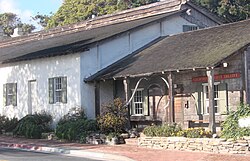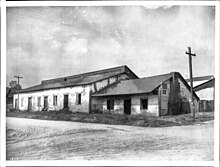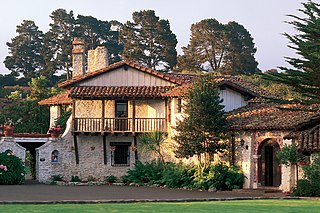
Monterey is a city in Monterey County on the southern edge of Monterey Bay on the U.S. state of California's Central Coast. Founded on June 3, 1770, Monterey was the second permanent settlement established by Spanish explorers in what is now California. It functioned as the capital of Alta California under both Spain (1804–1821) and Mexico (1822–1846). During this period, Monterey hosted California's first theater, public building, public library, publicly funded school, printing press, and newspaper. It was originally the only port of entry for all taxable goods in California. In 1846, during the Mexican–American War of 1846–1848, the United States Flag was raised over the Customs House. After Mexico ceded California to the U.S. at the end of the war, Monterey hosted California's first constitutional convention in 1849.

Mission San Carlos Borromeo del Río Carmelo, or Misión de San Carlos Borromeo de Carmelo, first built in 1797, is one of the most authentically restored Catholic mission churches in California. Located at the mouth of Carmel Valley, California, it is on the National Register of Historic Places and is a National Historic Landmark.

Carmel-by-the-Sea, commonly known simply as Carmel, is a city in Monterey County, California, located on the Central Coast of California. As of the 2020 census, the town had a total population of 3,220, down from 3,722 at the 2010 census. Situated on the Monterey Peninsula, Carmel is a popular tourist destination, known for its natural scenery and rich artistic history.

Monterey State Historic Park is a historic state park in Monterey, California. It includes part or all of the Monterey Old Town Historic District, a historic district that includes 17 contributing buildings and was declared a National Historic Landmark in 1970. The grounds include California's first theatre, and the Monterey Custom House, where the American flag was first raised over California.

The Pacific Repertory Theatre is a non-profit California corporation, based in Carmel-by-the-Sea, California, that produces theatrical productions and events, including the annual Carmel Shakespeare Festival. It is one of eight major arts institutions in Monterey County, as designated by the Community Foundation of Monterey County, and is supported in part by grants from the David and Lucile Packard Foundation, The Shubert Foundation, the Berkshire Foundation and the Monterey Peninsula Foundation.

The Forest Theater is an historic amphitheater in Carmel-by-the-Sea, California. Founded in 1910, it is one of the oldest outdoor theaters west of the Rockies. Actor/director Herbert Heron is generally cited as the founder and driving force, and poet/novelist Mary Austin is often credited with suggesting the idea. As first envisioned, original works by California authors, children's theatre, and the plays of Shakespeare were the primary focus. Since its inception, a variety of artists and theatre groups have presented plays, pageants, musical offerings and other performances on the outdoor stage, and the facility's smaller indoor theatre and school.

Stephen Moorer is a stage actor, director, producer and non-profit administrator based on the Central California Coast. He founded the only year-round professional theatre in Monterey County, GroveMont Theatre in 1982, renaming the non-profit organization Pacific Repertory Theatre in 1994, when the group acquired the Golden Bough Playhouse in Carmel-by-the-Sea, California.
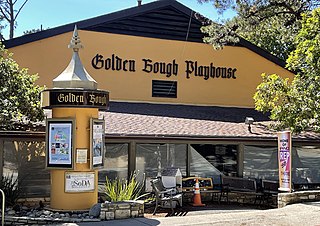
The Golden Bough Playhouse is a historic three-story theatre in Carmel-by-the-Sea, California on Monte Verde St., between 8th and 9th Avenues. The playhouse occupies the site of the former Carmel Arts and Crafts Club, Carmel's first cultural center and theatre, built in 1906–1907 on Casanova Street, and the Arts and Crafts Hall, built in 1923–1924 on an adjacent lot on Monte Verde Street. Since 1994, the facility has been owned and operated by Pacific Repertory Theatre, Monterey County's only year-round professional theatre company. A two-phase renovation of the aging facility began with an interior building project in 2011. A second phase project, including both interior and exterior renovations, is scheduled for 2023-2024. The theatre was recorded with the National Register of Historic Places on July 3, 2002. It is significant as a California historic building because it is located on the original site of the Carmel Arts and Crafts Club and Hall, the oldest indoor performing arts venues in Carmel.

The House of the Four Winds, or La Casa de Los Vientos, is a historic adobe building located at 540 Calle Principal in Monterey, California. It was built by Thomas O. Larkin in 1834. The house acquired its named because of the weather vane on its hipped roof. The building was used as the first State of California Hall of Records. Today it is used as the clubhouse for the Monterey Civic Club. The building is listed as a California Historical Landmark #353.

The Larkin House is a historic house at 464 Calle Principal in Monterey, California. Built in 1835 by Thomas O. Larkin, it is claimed to be the first two-story house in all of California, with a design combining Spanish Colonial building methods with New England architectural features to create the popular Monterey Colonial style of architecture. The Larkin House is both a National and a California Historical Landmark, and is a featured property of Monterey State Historic Park.
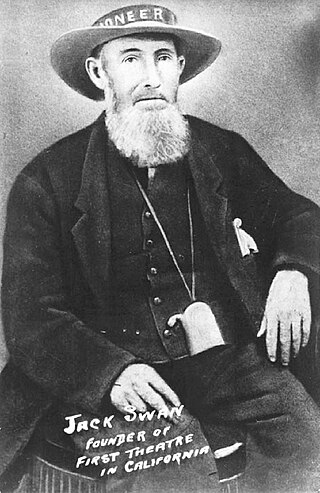
John Alfred "Jack" Swan, also known as Jack Swan, was a prominent California pioneer who arrived in Monterey in 1843. He is credited with founding the First theater in California, around 1845, and helping Commodore John Drake Sloat raise the American flag over the Custom House, declaring California as part of the United States during the American Conquest of California.

The Sunset Center is located in Carmel-by-the-Sea, California, United States. It is a performing arts center which features concerts, comedy, theatre, and dance. Formerly the Sunset School, the site was purchased by the city of Carmel in 1965 with the plan to develop it into a cultural center. It is home to the Carmel Bach Festival. It was listed on the National Register of Historic Places on January 9, 1998.

The Stevenson House, is a historic two-story Spanish Colonial style building located at 530 Houston Street in Monterey, California. It was a boarding house called the French Hotel, built circa 1836. The Scottish author Robert Louis Stevenson lived there in 1879, writing and courting his future wife. It is now a museum and property of the Monterey State Historic Park. The building was listed on the National Register of Historic Places on January 7, 1972. The building is also listed as a California historical landmark #352.
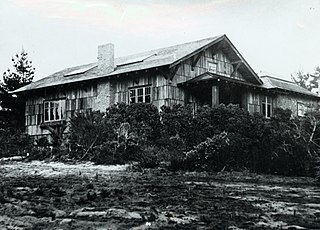
The Carmel Arts and Crafts Club was an art gallery, theatre and clubhouse founded in 1905, by Elsie Allen, a former art instructor for Wellesley College. After using the facilities of various town parks and hotels, in 1907, a clubhouse was built at Monte Verde Street in Carmel-by-the-Sea, California, where the Circle Theatre of the Golden Bough Playhouse is today. The clubhouse served as Carmel's first community cultural center. It held dramatic performances, poetry readings, lectures, and was a summer school for the arts. Between 1919 and 1948 Carmel was the largest art colony on the Pacific coast.

Herbert "Bert" Heron was an American writer, actor, and poet. Heron is best known for founding the Forest Theater in 1910. He was the former mayor of Carmel-by-the-Sea, California, for two terms in the 1920s. He lived in Carmel for 62 years.

Edward Gerhard Kuster was a musician and attorney from Los Angeles for twenty-one years before coming to Carmel-by-the-Sea, California in 1921. He became involved in theater and establish his own theatre and school. He built the Theatre of the Golden Bough in 1924, and a second theater, the Golden Bough Playhouse in 1952. Kuster directed 85 plays and acted in more than 50 roles in the 35 years he lived in Carmel.
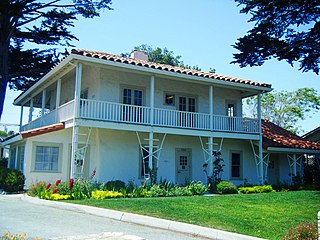
The Vásquez House, also known as Vásquez Adobe, is a historic two-story adobe building located at 546 Dutra Street in Monterey, California. It was occupied by Dolores a sister of Tiburcio Vásquez (1835–1875), who was a Californio bandido that was active in California from 1854 to 1874. The building is listed as a California Historical Landmark #351. It is owned by the City of Monterey, which uses it as the administrative office of its Park and Recreation Department.

Hazel Watrous was an American writer who was co-founder of Denny-Watrous Management. The company presented performances in Carmel-by-the-Sea, California. She and Dene Denny played roles in founding the Carmel Music Society, the Carmel Bach Festival, and Monterey's First Theater. They hosted musical concerts and lectures from their home. In addition, they established the Denny-Watrous Gallery.
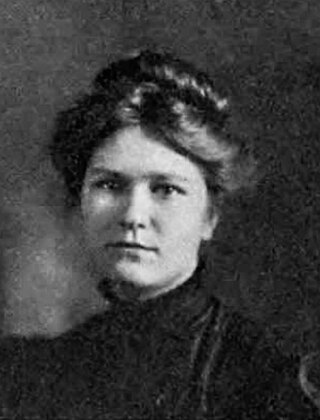
Dene Denny was an American musical theater producer who, along with co-founder Hazel Watrous, established the Denny-Watrous Management. They played pivotal roles in the founding of the Carmel Music Society, the Carmel Bach Festival, and Monterey's First Theater. Their residence, the Denny-Watrous Studio , served as a hub for hosting musical concerts and lectures.
